Search
Remove Ads
Advertisement
Search Results
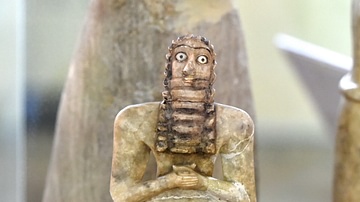
Image
Male Worshiper from Tell Asmar Hoard, Iraq Museum
This is a votive statuette of a male Sumerian worshiper from the Square Temple of Abu at Tell Asmar (ancient Eshnunna, Mesopotamia, Iraq), Early Dynastic III, 2600-2400 BCE. Excavated by the Oriental Institute of the University of Chicago...
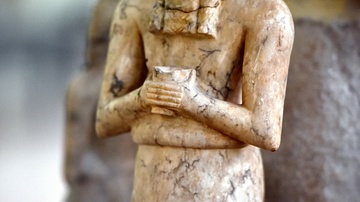
Image
Statuette of Male Worshiper, Tell Asmar Hoard
This is a votive statuette of a male Sumerian worshiper from the Square Temple of Abu at Tell Asmar (ancient Eshnunna, Mesopotamia, Iraq), Early Dynastic III, 2600-2400 BCE. Excavated by the Oriental Institute of the University of Chicago...
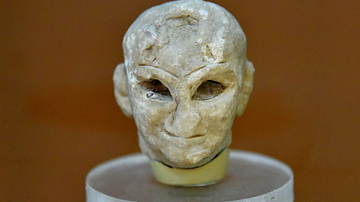
Image
Head of a Sumerian Male from Tell Asmar
Limestone head of a statue of a Sumerian male; the rest of the body is lost. The eye sockets are empty but might well have been filled in with a white shell or a precious stone set in bitumen. Front view. From the Single-Shrine at the Temple...
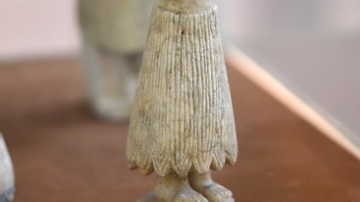
Image
Votive Statue of Male Worshiper, Tell Asmar Hoard
This is a votive statuette of a male Sumerian worshiper from the Square Temple of Abu at Tell Asmar (ancient Eshnunna, Mesopotamia, Iraq), Early Dynastic III, 2600-2400 BCE. Excavated by the Oriental Institute of the University of Chicago...
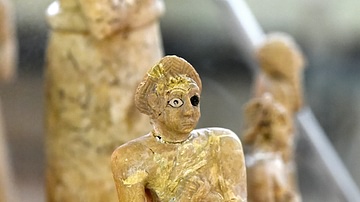
Image
Female Worshiper from Tell Asmar Hoard at the Iraq Museum
This is a votive statuette of a female Sumerian worshiper from the Square Temple of Abu at Tell Asmar (ancient Eshnunna, Mesopotamia, Iraq), Early Dynastic III, 2600-2400 BCE. Excavated by the Oriental Institute of the University of Chicago...
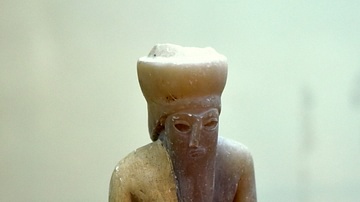
Image
Male Worshiper from Tell Asmar Hoard at the Iraq Museum
This is a votive statuette of a male Sumerian worshiper from the Square Temple of Abu at Tell Asmar (ancient Eshnunna, Mesopotamia, Iraq), Early Dynastic III, 2600-2400 BCE. Excavated by the Oriental Institute of the University of Chicago...
![Head of a Sumerian Male from Tell Asmar [Right Side]](https://www.worldhistory.org/img/c/p/360x202/9687.jpg?v=1599123604)
Image
Head of a Sumerian Male from Tell Asmar [Right Side]
Limestone head of a statue of a Sumerian male; the rest of the body is lost. The eye sockets are empty but might well have been filled in with a white shell or a precious stone set in bitumen. Side view, right. From the Single-Shrine at the...
![Head of a Sumerian Male from Tell Asmar [Left Side]](https://www.worldhistory.org/img/c/p/360x202/9688.jpg?v=1599124502)
Image
Head of a Sumerian Male from Tell Asmar [Left Side]
Limestone head of a statue of a Sumerian male; the rest of the body is lost. The eye sockets are empty but might well have been filled in with a white shell or a precious stone set in bitumen. Side view, left. From the Single-Shrine at the...
![Head of a Sumerian Male from Tell Asmar [Rear View]](https://www.worldhistory.org/img/c/p/360x202/9689.jpg?v=1599124502)
Image
Head of a Sumerian Male from Tell Asmar [Rear View]
Limestone head of a statue of a Sumerian male; the rest of the body is lost. The eye sockets are empty but might well have been filled in with a white shell or a precious stone set in bitumen. Me holding the head. Back view. From the Single-Shrine...

Definition
Code of Ur-Nammu
The Code of Ur-Nammu (c. 2100-2050 BCE) is the oldest extant law code in the world. It was written by the Sumerian king Ur-Nammu (r. 2047-2030 BCE) or his son Shulgi of Ur (r. 2029-1982 BCE) centuries before the famous Code of Hammurabi was...